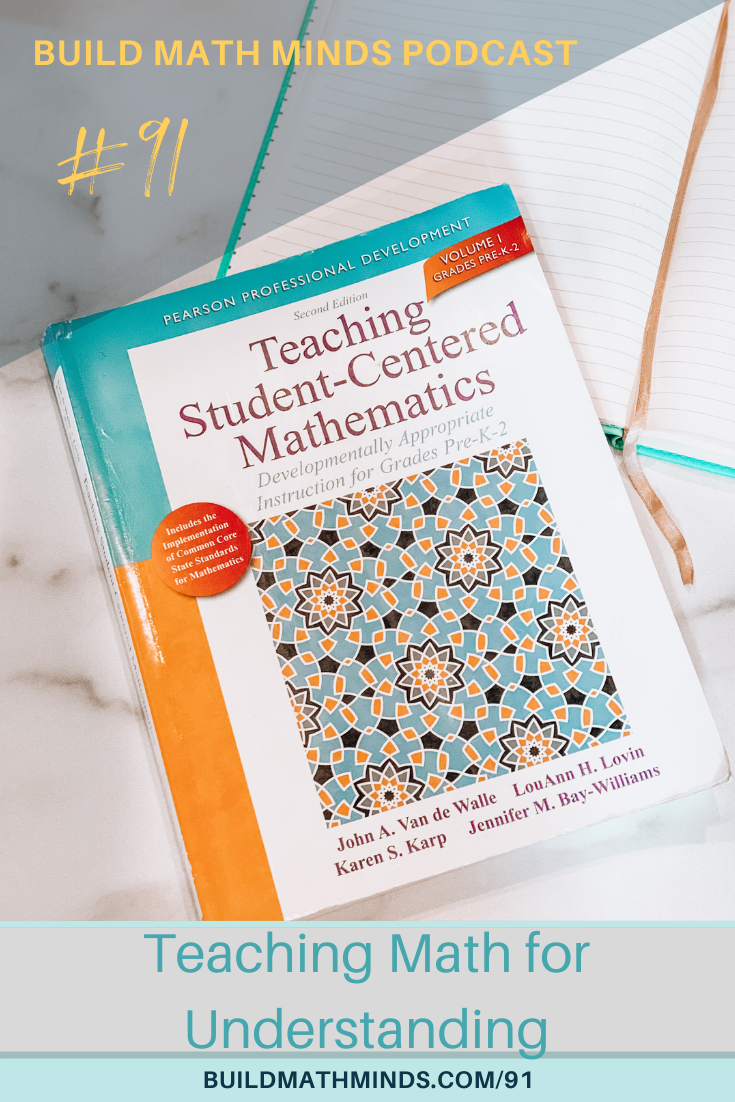Resources mentioned in this episode:
Teaching Student-Centered Mathematics series by John Van de Walle, LouAnn Lovin, Karen Karp, and Jennifer Bay-Williams – see books for PreK-2, 3-5, and 6-8
Welcome fellow Recovering Traditionalists to Episode 91. Today we are taking a look at Teaching Math for Understanding.
In last week’s podcast I briefly mentioned The Flexibility Formula. The Flexibility Formula are the pillars of math instruction that help us be able to build students’ flexibility with mathematics.
#1: Understanding – we need to build our own understanding of the math content before we can build it for our students. If we don’t fully understand the mathematics and we’re not flexible ourselves, it’s hard to help our students build their own flexibility
#2: Observing – the best way to assess our students’ understanding and misunderstandings of math is through observation.
#3: Connecting – is about helping students see how math concepts are connected together and connected throughout the grades instead of learning math as a set of isolated skills and information.
#4: Experiencing – the types of experiences we provide kids around mathematics dictates what they think math is about.
In today’s podcast I want to discuss the Understanding pillar in The Flexibility Formula. It took me a long time to figure out that there is a difference between doing math and understanding math. I was a do-er of mathematics and it wasn’t until I taught math that I realized being able to do math doesn’t always help you be able to teach math because our understanding of the math is limited.
The book I call my Math Bible is one of the places that helped change my thinking about what the teaching and learning of math should be like.
On page 1, in the opening paragraph to Teaching Student-Centered Mathematics by John Van de Walle, LouAnn Lovin, Karen Karp, and Jennifer Bay-Williams, they write:
“What is understanding? Understanding is being able to think and act flexibly with a topic or concept. It goes beyond knowing; it is more than a collection of information, facts, or data. It is more than being able to follow steps in a procedure. One hallmark of mathematical understanding is a student’s ability to justify why a given mathematical claim or answer is true or why a mathematical rule makes sense (Council of Chief State School Officers, 2010). Although children might know their basic multiplication facts and be able to give you quick answers to questions about these facts, they might not understand multiplication. They might not be able to justify how they know an answer is correct or provide an example of when it would make sense to use this basic fact. These tasks go beyond simply knowing mathematical facts and procedures. Understanding must be a primary goal for all of the mathematics you teach.”
If understanding is a primary goal for all the mathematics you teach, it can be difficult if you yourself don’t have an understanding. Many of us were taught math in a way that only gave us the knowledge of the steps and procedures. Maybe you memorized your multiplication facts but had no idea what 3×7 actually means. Whatever the math concept was, many of us educators were only ever taught the math in a way that it was seen as a set of information to be learned and memorized. We even have sayings like “ours is not to question why, just invert and multiply!”
We have been trained that math is not something we need to understand, we just need to be able to DO it. It’s time that changes.
That’s why Understanding is the first pillar in my Flexibility Formula. It is the most important. We must first build our math minds so that we can build the math minds of our students. We have to build our understanding of the math so that we can help our students build their understanding.
Whatever math concept you are wanting your students to build understanding of, you first must make sure you have an understanding of it. One of the first places that needs to change is in our understanding of the “facts.”
Addition and multiplication facts were some of the main math concepts that we were not taught to understand, we were just taught to DO them. So if you’ve ever struggled with helping your students gain fluency with their addition and multiplication facts I have a new resource that’s completely free to help guide you through how to build your students’ fluency.
Below you will find the Step-by-Step Guide to Increase Elementary Students’ Math Fluency. The guide is a workbook you will fill out as you watch my training videos on how to build students’ fluency with their “facts.”
Subscribe and Review in iTunes
Hey, are you subscribed to the Build Math Minds Podcast, yet? If you’re not, make sure to do that today because I don’t want you to miss any episodes! Click here to subscribe to the podcast in iTunes.
While you’re there, don’t forget to leave a review on iTunes too. I would love to know your thoughts and how we can make sure that we give you content that you will really enjoy.
To leave a review, head over to iTunes and click on “Ratings and Reviews” and “Write a Review.” I can’t wait to hear your thoughts about the podcast.




